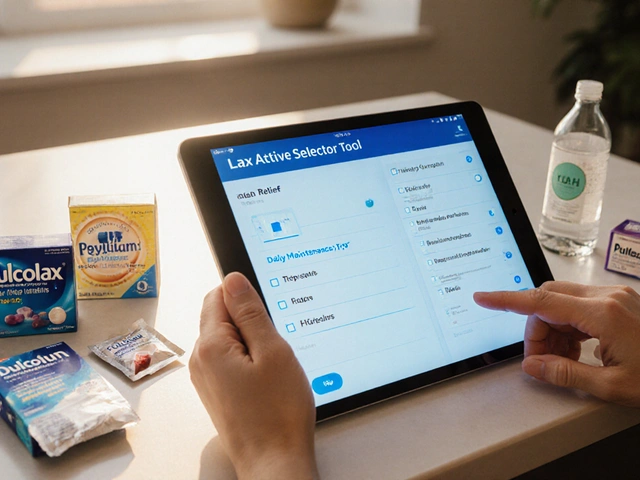Beta-Blocker Selector
Answer the questions below to find the most suitable beta-blocker for your condition.
Zebeta is a brand‑name beta‑blocker whose generic name is bisoprolol. It works by slowing the heart’s rhythm and lowering blood pressure, making it useful for conditions like hypertension and chronic heart failure. Doctors often prescribe it when they need a cardio‑selective option that targets beta‑1 receptors in the heart while sparing the lungs.
- Know what makes Zebeta cardio‑selective and why that matters.
- See side‑effect profiles side‑by‑side with four common alternatives.
- Get quick dosage and half‑life facts for each drug.
- Find a handy checklist to match your health goals with the right beta‑blocker.
- Learn practical tips for switching or combining therapies.
What sets Zebeta apart from other beta‑blockers?
Bisoprolol belongs to the class of beta‑blockers that primarily block the beta‑1 receptors in the heart. This cardio‑selectivity means fewer breathing problems for people with asthma or COPD compared with non‑selective options. Zebeda’s half‑life hovers around 10‑12 hours, allowing once‑daily dosing for most patients. Its typical starting dose for hypertension is 5mg once daily, which can be titrated up to 20mg.
Common alternatives and how they differ
When you sit down with your GP, you’ll probably hear about a few other beta‑blockers. Below is a quick snapshot of the most frequently prescribed ones.
Atenolol is a well‑known cardio‑selective blocker, but it has a shorter half‑life (about 6‑7hours) and often requires twice‑daily dosing. It’s been around since the 1970s and is cheaper as a generic, which can be a deciding factor for budget‑conscious patients. Metoprolol comes in two formulations: tartrate (immediate‑release) and succinate (extended‑release). The succinate version lets you take it once daily, similar to Zebeta, while the tartrate needs split doses. Metoprolol’s half‑life ranges from 3‑7hours, and it’s a bit less cardio‑selective than bisoprolol. Carvedilol is a non‑selective beta‑blocker that also blocks alpha‑1 receptors, giving it added vasodilatory effects. This makes it a solid choice for heart‑failure patients, but the broader receptor coverage can cause more fatigue and dizziness. Lisinopril isn’t a beta‑blocker at all; it’s an ACE inhibitor often paired with beta‑blockers to hit high blood pressure from two angles. Including it here helps illustrate how doctors sometimes layer drug classes for tougher cases.Side‑effect showdown
All beta‑blockers share a core set of possible side effects, but the likelihood and severity differ. Here’s a quick rundown:
- Fatigue: Most common with carvedilol and high‑dose metoprolol.
- Cold hands/feet: Seen across the board, but especially with atenolol.
- Bradycardia (slow heart rate): More likely with high cardio‑selective doses like bisoprolol.
- Bronchospasm: A risk with non‑selective agents; bisoprolol’s selectivity lowers this risk.
- Sexual dysfunction: Reported with all beta‑blockers, though data vary.
Remember, side‑effects are highly individual. Some people tolerate carvedilol perfectly, while others feel dizzy on a low dose of metoprolol.

Comparison table
| Drug | Typical dose (mg) | Half‑life (hrs) | Beta‑1 selectivity | Key side‑effects |
|---|---|---|---|---|
| Zebeta (Bisoprolol) | 5-20 once daily | 10-12 | High | Bradycardia, fatigue, cold extremities |
| Atenolol | 25-100 once daily | 6-7 | Moderate | Cold hands/feet, insomnia, GI upset |
| Metoprolol succinate | 25-200 once daily | 3-7 | Moderate‑high | Fatigue, dizziness, depression |
| Carvedilol | 3.125-25 twice daily | 7-10 | Low (non‑selective) | Fatigue, hypotension, bronchospasm |
Choosing the right beta‑blocker for you
Here’s a quick decision‑tree you can run through with your clinician:
- Do you have asthma or COPD? Yes → Prefer a highly cardio‑selective drug like Zebeta or atenolol.
- Is heart failure your primary concern? Yes → Carvedilol’s alpha‑blocking adds vasodilation, which can be beneficial.
- Are you on a tight budget? Yes → Generic atenolol or metoprolol tartrate are usually cheaper.
- Do you experience frequent fatigue on medication? Yes → Start low with bisoprolol and titrate slowly; consider metoprolol succinate for smoother release.
- Do you need once‑daily dosing for convenience? Yes → Zebeta, metoprolol succinate, or lisinopril (if added) are good fits.
Always discuss these points with your prescriber; they’ll weigh your medical history, other meds, and lifestyle.
Practical tips for starting or switching
- Never halve or double a dose without medical advice - abrupt changes can spike blood pressure.
- If you’re moving from a non‑selective to a cardio‑selective blocker, your doctor may overlap the two for a few days to avoid rebound tachycardia.
- Take the pill at the same time each day, preferably in the morning to reduce nighttime dizziness.
- Monitor your pulse and blood pressure weekly for the first month after any change.
- Report any new shortness of breath promptly; it could signal a need to adjust the regimen.
Quick reference checklist
- Zebeta (Bisoprolol): Cardio‑selective, once daily, good for asthma‑friendly patients.
- Atenolol: Cheap, twice‑daily optional, moderate selectivity.
- Metoprolol succinate: Extended‑release, flexible dosing, moderate‑high selectivity.
- Carvedilol: Non‑selective, adds vasodilation, best for heart‑failure with reduced ejection fraction.
- Lisinopril: ACE inhibitor, not a beta‑blocker, often paired for added BP control.

Frequently Asked Questions
Can I take Zebeta with other blood‑pressure meds?
Yes, doctors often combine beta‑blockers with ACE inhibitors, diuretics, or calcium‑channel blockers to hit blood pressure from multiple angles. Your prescriber will watch for additive drops in heart rate.
What should I do if I miss a dose?
Take the missed tablet as soon as you remember, unless it’s almost time for your next dose. In that case, skip the missed one and continue with your regular schedule - don’t double‑dose.
Is Zebeta safe during pregnancy?
Beta‑blockers cross the placenta and can affect fetal heart rate. They’re generally avoided unless the benefits outweigh the risks. Talk to your obstetrician for personalized advice.
How long does it take to feel the benefits?
Blood‑pressure reductions can appear within a few days, but heart‑failure benefits often need 2‑4 weeks of steady dosing.
Can I switch from Atenolol to Zebeta easily?
Doctors typically taper Atenolol over a week while introducing a low dose of bisoprolol. This prevents a sudden jump in heart rate or blood pressure.






Matthew Balbuena
Yo, love the deep dive on beta‑blockers – super helpful! I especially dig the part about cardio‑selectivity and why it matters for folks with asthma. The table is clean and makes it easy to compare half‑lives. Also, the budget tip about atenolol being cheap is a real win. Keep the good vibes coming, this kinda info rocks the pharmacy world.
michael abrefa busia
Great point, Matthew! 🙌 The side‑effect showdown really helps patients weigh pros and cons. I’d add that staying consistent with dosing time can cut down on dizziness. 👍 Also, the quick checklist at the end is perfect for a rapid review before a doctor visit. Keep the energy flowing, this guide is gold! 😊
Bansari Patel
The interplay between receptor selectivity and pulmonary safety is not merely a footnote; it is a cornerstone of personalized medicine. When you consider the beta‑1 dominance of bisoprolol, you recognize its capacity to spare bronchial smooth muscle, which is vital for asthmatic patients. Yet, the narrative often overlooks the nuanced pharmacodynamics that influence heart‑rate variability under stress. A deeper look reveals that carvedilol’s non‑selective profile can precipitate bronchospasm, especially in high‑dose regimens, contradicting the simplistic “one size fits all” narrative. Moreover, half‑life differences dictate dosing frequency, but they also affect steady‑state plasma concentrations, which in turn shape side‑effect profiles. The 10‑12 hour half‑life of zebeta lends itself to once‑daily dosing, reducing peaks and troughs that may cause fatigue. In contrast, atenolol’s shorter half‑life can cause nocturnal lows if not timed correctly. The importance of titration cannot be overstated; a low‑and‑slow approach with bisoprolol mitigates bradycardia risk while preserving antihypertensive efficacy. Pharmacogenomic variability further complicates the equation, as CYP2D6 polymorphisms alter metabolism rates for many beta‑blockers. Clinical guidelines emphasize integrating these genetic insights, yet many practitioners remain blissfully ignorant of them. The decision tree included in the article is a solid scaffold, but it should be supplemented with patient‑specific data such as ejection fraction, comorbid COPD severity, and renal function. Finally, the interplay with other antihypertensives, especially ACE inhibitors like lisinopril, can create synergistic blood‑pressure reductions but also amplify the risk of hypotension if not monitored. In sum, choosing the right beta‑blocker is a multifactorial puzzle that demands attention to receptor selectivity, pharmacokinetics, genetics, and comorbid conditions, rather than a simplistic cost‑or‑convenience trade‑off.
Rebecca Fuentes
Thank you for the thoughtful exposition. Your emphasis on genetic polymorphisms aligns with current precision‑medicine recommendations. It would be prudent to reference specific CYP2D6 alleles when discussing metabolism variations. Additionally, noting the potential for additive hypotensive effects when combining beta‑blockers with ACE inhibitors could enhance clinical safety. Overall, the analysis offers a comprehensive framework for clinicians.
Jacqueline D Greenberg
Hey everyone, just wanted to say this guide made my doctor’s office visit way less stressful. I liked the tip about monitoring pulse weekly after a switch – totally helped me feel in control. The friendly tone made the science feel less intimidating. Thanks for breaking it down so clearly!
Jim MacMillan
While your sentiment is appreciated, let us not forget that the discourse surrounding pharmacotherapy is steeped in rigorous evidence, not merely anecdotal relief. The nuanced differences in receptor affinity merit a scholarly appraisal beyond layperson reassurance. 🤓 Nonetheless, your enthusiasm is noted; perhaps channel it toward a more erudite critique next time. 🧐
Dorothy Anne
Love the quick reference checklist – super handy!
True Bryant
Honestly, most readers miss the critical fact that beta‑blockers are contraindicated in acute decompensated heart failure without careful uptitration. The cascade of neurohormonal activation can precipitate worsening edema if the drug is introduced abruptly. Moreover, the article glosses over the fact that carvedilol’s alpha‑blocking properties demand a distinct titration schedule compared to pure cardio‑selective agents. Ignoring these protocol nuances is a disservice to both prescribers and patients. In practice, the bedside assessment of volume status should guide initiation, not just the abstract tables presented. Also, the potential for drug‑drug interactions with calcium channel blockers, particularly verapamil, is understated here.
Danielle Greco
Just a quick grammar note: the phrase “beta‑blocker’s” should be written as "beta‑blockers" when referring to the class. Also, “once‑daily dosing” is hyphenated correctly – nice job! 😊 Keep the content crisp and clear.
Linda van der Weide
Thanks for the heads‑up on the punctuation, Danielle! Those little details do make a big difference in readability. I appreciate the friendly tone and will keep an eye on those hyphens next time I edit a post.